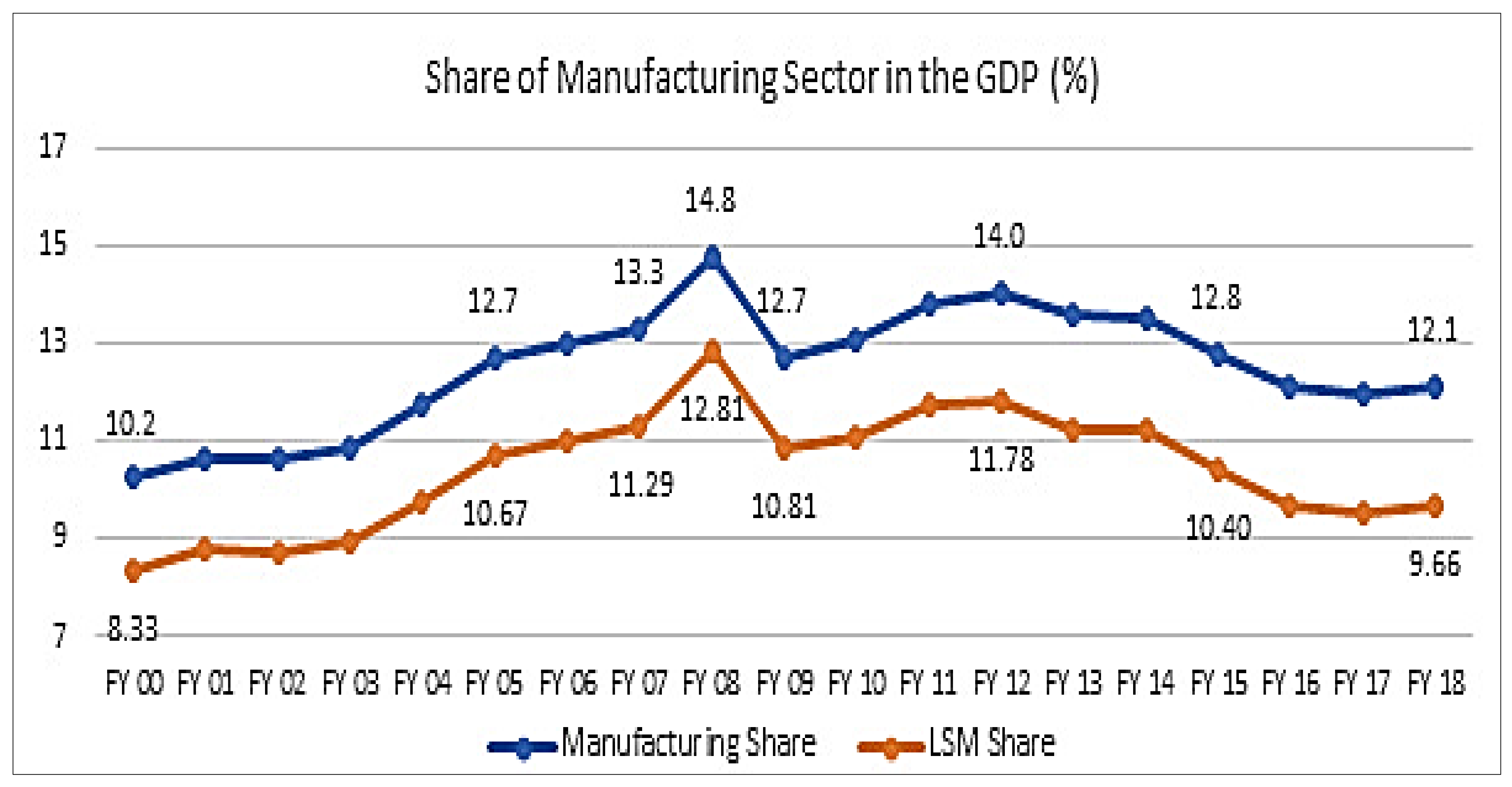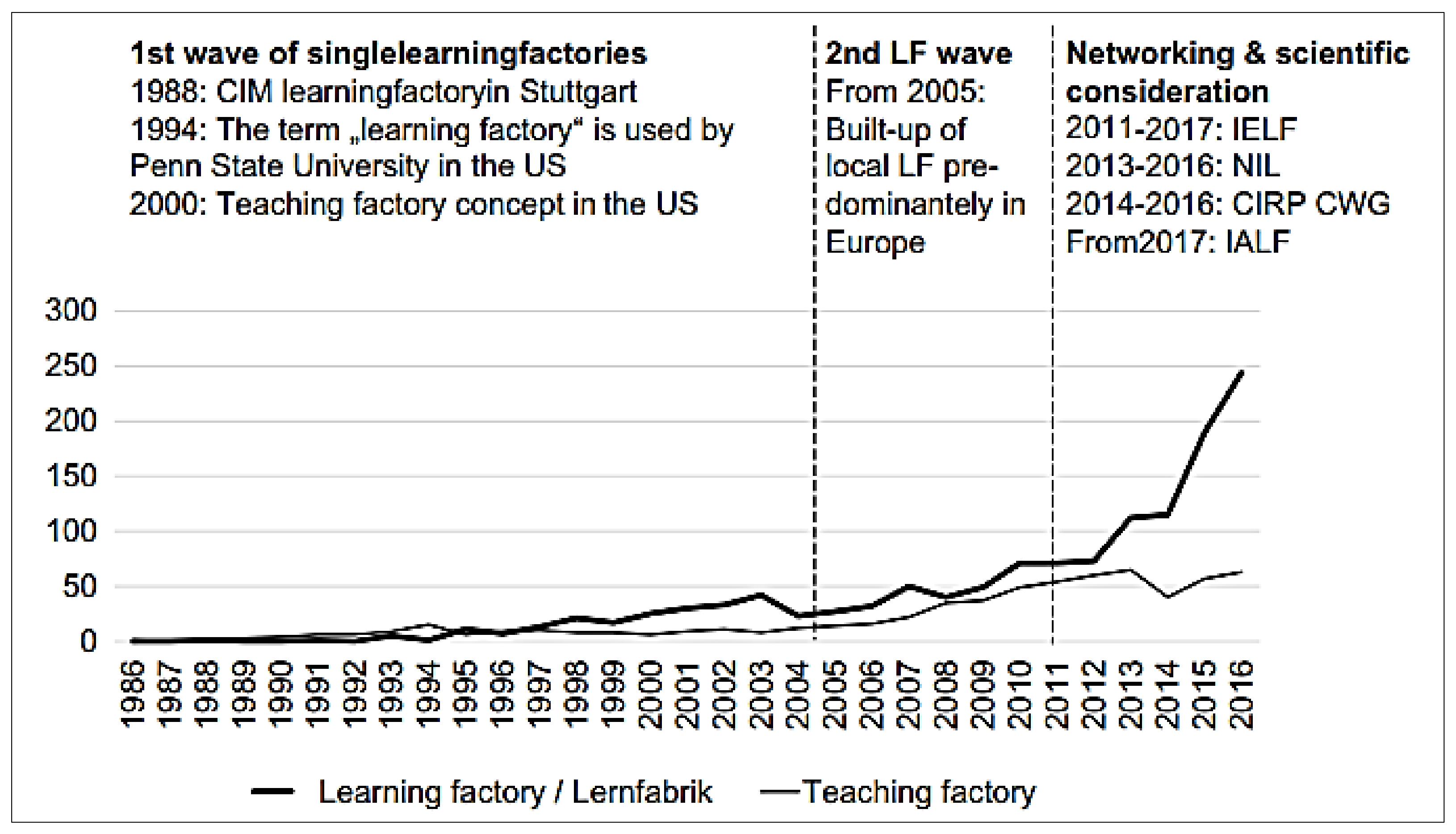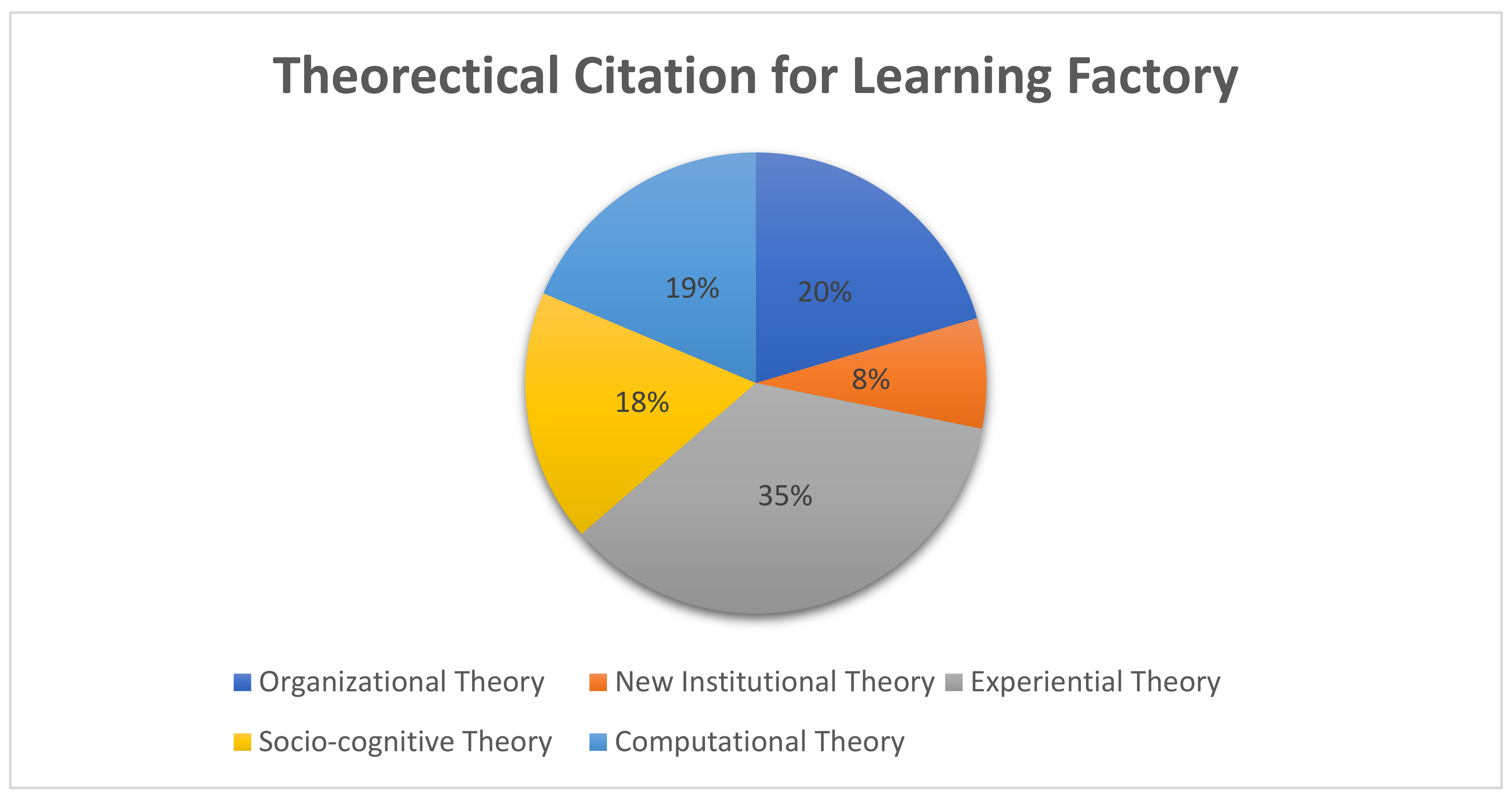Sustainability through Factory-Based Learning in Higher Education
Abstract
1. Introduction
2. Methodology
3. Results and Findings
3.1. Themes Extacted from the Content Analysis
3.2. Biblomatric Analysis
3.3. Historical Developent
3.4. Theoretical Perspective of the Learning Factory
3.5. Comparison of the Skill Level of the Graduates
3.6. Case Study of LF at UMP, Malaysia
3.7. Thematic Analysis of the Interview
3.7.1. The Thematic Analysis of the Responses from P1.1–5
3.7.2. The Thematic Analysis of the Responses from P2.1–4
3.8. Discussion: Collaboration and Establishment of LF in HEIs
4. Conclusions and Recommendations
Author Contributions
Funding
Institutional Review Board Statement
Informed Consent Statement
Data Availability Statement
Conflicts of Interest
References
- Baloch, N.; Siming, L.; Abraha, A.; Hong, S. Faculty research productivity: Differences between foreign and local doctoral degree holders in Pakistan. High. Educ. 2020, 82, 203–225. [Google Scholar] [CrossRef]
- Centea, D.; Elbestawi, M.; Singh, I.; Wanyama, T. SEPT Learning Factory Framework. In Smart Industry & Smart Education; Auer, M., Langmann, R., Eds.; Springer: Cham, Swizerland, 2019; pp. 354–362. [Google Scholar] [CrossRef]
- Wagner, P.; Prinz, C.; Wannöffel, M.; Kreimeier, D. Learning Factory for Management, Organization and Workers’ Participation. Procedia CIRP 2015, 32, 115–119. [Google Scholar] [CrossRef]
- Ali, M.; Ullah, S.; Ahmad, M.S.; Cheok, M.Y.; Alenezi, H. Assessing the impact of green consumption behavior and green purchase intention among Millennials Toward Sustainable Environment. Environ. Sci. Pollut. Res. 2022, 30, 23335–23347. [Google Scholar] [CrossRef]
- Ahmad, M.; Turi, J.A.; Al-Dala’ie, R.N.S.; Manan, A. Potential use of recycled materials on rooftops to improve thermal comfort in sustainable building construction projects. Front. Built Environ. 2022, 235, 1014473. [Google Scholar] [CrossRef]
- Al-Hussaini, S.H.; Turi, J.A.; Altamimi, A.N.A.; Khan, M.A.; Ahmad, M. Impact of talent management strategies on employee performance behaviour with the mediating role of talent management outputs. Arch. Bus. Res. 2019, 7. [Google Scholar] [CrossRef]
- Qinhua, Z.; Dongming, M.; Zhiying, N.; Hao, X. Origin and overview of the adult “Lifelong learning competency” research program in Beijing. In Adult Competencies for Lifelong Learning; River Publishers: New York, NY, USA, 2022; pp. 1–4. [Google Scholar] [CrossRef]
- Tisch, M.; Hertle, C.; Abele, E.; Metternich, J.; Tenberg, R. Learning factory design: A competency-oriented approach integrating three design levels. Int. J. Comput. Integr. Manuf. 2015, 29, 1355–1375. [Google Scholar] [CrossRef]
- Azadivar, F.; Kramer, B. Rewards and Challenges of Utilizing University Research/Economic Development Centers for Enhancing Engineering Education; Annual Conference & Exposition; American Society for Engineering Education: Washington, DC, USA, 2007; Volume 1154. [Google Scholar]
- Enke, J.; Metternich, J.; Bentz, D.; Klaes, P.-J. Systematic learning factory improvement based on maturity level assessment. Procedia Manuf. 2018, 23, 51–56. [Google Scholar] [CrossRef]
- Tısch, M.; Ranz, F.; Abele, E.; Metternıch, J.; Vera, H. Learning Factory Morphology—Study of Form and Structure of An Innovative Learning Approach in the Manufacturing Domain. Turk. Online J. Educ. Technol. 2015, 14, 356–364. Available online: https://d-nb.info/1129262421/34 (accessed on 1 February 2023).
- Lamancusa, J.S.; Jorgensen, J.E.; Zayas-Castro, J.L. The Learning Factory-A New Approach to Integrating Design and Manufacturing into the Engineering Curriculum. J. Eng. Educ. 1997, 86, 103–112. [Google Scholar] [CrossRef]
- Leal, L.F.; Fleury, A.; Zancul, E. Starting up a Learning Factory focused on Industry 4.0. Procedia Manuf. 2020, 45, 436–441. [Google Scholar] [CrossRef]
- Dlouhá, J.; Macháčková-Henderson, L.; Dlouhý, J. Learning networks with involvement of higher education institutions. J. Clean. Prod. 2013, 49, 95–104. [Google Scholar] [CrossRef]
- Abele, E.; Chryssolouris, G.; Sihn, W.; Metternich, J.; ElMaraghy, H.; Seliger, G.; Sivard, G.; ElMaraghy, W.; Hummel, V.; Tisch, M.; et al. Learning factories for future oriented research and education in manufacturing. CIRP Ann. 2017, 66, 803–826. [Google Scholar] [CrossRef]
- Brookfield, S. Adult learning: An overview. Int. Encycl. Educ. 1995, 10, 375–380. [Google Scholar]
- Darun, M.; Palm, D.; Athinarayanan, R.; Hummel, V.; von Leipzig, K. The Learning Factory—A New Stimulus to Enhance International Collaboration. Procedia Manuf. 2019, 31, 290–295. [Google Scholar] [CrossRef]
- Toheed, H.; Turi, J.A.; Ramay, M.I. Exploring the Consequences of Organizational Cynicism. Int. J. Eur. Stud. 2019, 3, 1. [Google Scholar] [CrossRef]
- Ahamd, M. State of the Art Compendium of Macro and Micro Energies. Adv. Sci. Technol. Res. J. 2019, 13, 88–109. [Google Scholar] [CrossRef]
- Alfahad, B.S.M.; Alabdullah, S.F.I.; Ahmad, M. Investigation of the Critical Factors Influencing Low-Cost Green Sustainable Housing Projects in Iraq. Math. Stat. Eng. Appl. 2022, 71, 310–329. [Google Scholar] [CrossRef]
- Bashir, S.; Khwaja, M.G.; Rashid, Y.; Turi, J.A.; Waheed, T. Green Brand Benefits and Brand Outcomes: The Mediating Role of Green Brand Image. SAGE Open 2020, 10, 1–11. [Google Scholar] [CrossRef]
- Burger, K.; Pitts, H.; Risk, J. Understanding Productivity Practices; University of Bristol: Bristol, UK, 2019. [Google Scholar]
- Cachay, J.; Wennemer, J.; Abele, E.; Tenberg, R. Study on Action-Oriented Learning with a Learning Factory Approach. Procedia Soc. Behav. Sci. 2012, 55, 1144–1153. [Google Scholar] [CrossRef]
- Pakistan Business council. Available online: https://www.pbc.org.pk/research/pakistans-economic-trade-manufacturing-data/ (accessed on 1 February 2023).
- Tisch, M.; Metternich, J. Potentials and Limits of Learning Factories in Research, Innovation Transfer, Education, and Training. Procedia Manuf. 2017, 9, 89–96. [Google Scholar] [CrossRef]
- Zhang, W.; Cai, W.; Min, J.; Fleischer, J.; Ehrmann, C.; Prinz, C.; Kreimeier, D. 5G and AI Technology Application in the AMTC Learning Factory. Procedia Manuf. 2020, 45, 66–71. [Google Scholar] [CrossRef]
- Lanza, G.; Minges, S.; Stoll, J.; Moser, E.; Haefner, B. Integrated and Modular Didactic and Methodological Concept for a Learning Factory. Procedia CIRP 2016, 54, 136–140. [Google Scholar] [CrossRef]
- Čada, K.; Ptáčková, K. Possibilities and limits of collaboration between science and NGOs in the Czech Republic. J. Clean. Prod. 2013, 49, 25–34. [Google Scholar] [CrossRef]
- Lozano, R. The state of sustainability reporting in universities. Int. J. Sustain. High. Educ. 2011, 12, 67–78. [Google Scholar] [CrossRef]
- Rasche, A. The United Nations Global Compact and the Sustainable Development Goals. In Research Handbook of Responsible Management; Edward Elgar Publishing: Cheltenham, UK, 2020; pp. 228–241. [Google Scholar] [CrossRef]
- Doner, R.; Schneider, B.R. Technical Education in the Middle-Income Trap: Building Coalitions for Skill Formation. J. Dev. Stud. 2019, 56, 680–697. [Google Scholar] [CrossRef]
- Dubey, A.; Mehndiratta, A.; Sagar, M.; Kashiramka, S. Reforms in technical education sector: Evidence from World Bank-assisted Technical Education Quality Improvement Programme in India. High. Educ. 2018, 78, 273–299. [Google Scholar] [CrossRef]
- Lamancusa, J.S.; Zayas, J.L.; Soyster, A.L.; Morell, L.; Jorgensen, J. 2006 Bernard M. Gordon Prize Lecture*: The Learning Factory: Industry-Partnered Active Learning. J. Eng. Educ. 2008, 97, 5–11. [Google Scholar] [CrossRef]
- Chryssolouris, G.; Mavrikios, D.; Mourtzis, D. Manufacturing Systems: Skills & Competencies for the Future. Procedia CIRP 2013, 7, 17–24. [Google Scholar] [CrossRef]
- Zuehlke, D. SmartFactory—From Vision to Reality in Factory Technologies. IFAC Proc. Vol. 2008, 41, 14101–14108. [Google Scholar] [CrossRef]
- Jaeger, A.; Mayrhofer, W.; Kuhlang, P.; Matyas, K.; Sihn, W. The “Learning Factory”: An immersive learning environment for comprehensive and lasting education in industrial engineering. In Proceedings of the 16th World Multi-Conference on Systemics, Cybernetics and Informatics, Orlando, FL, USA, 17–20 July 2012; Volume 16, pp. 237–242. [Google Scholar]
- Morell, L.; Trucco, M. A proven model to re-engineer engineering education in partnership with industry. In Proceedings of the World Engineering Education Forum, Buenos Aires, Argentina, 13 March 2012. [Google Scholar]
- Hulla, M.; Karre, H.; Hammer, M.; Ramsauer, C. A Teaching Concept Towards Digitalization at the LEAD Factory of Graz University of Technology. In The Challenges of the Digital Transformation in Education: Proceedings of the 21st International Conference on Interactive Collaborative Learning (ICL2018); Springer: Berlin/Heidelberg, Germany, 2019; Volume 2, pp. 393–402. [Google Scholar] [CrossRef]
- Pinilla, L.S.; Rodríguez, R.L.; Gandarias, N.T.; de Lacalle, L.N.L.; Farokhad, M.R. TRLs 5–7 Advanced Manufacturing Centres, Practical Model to Boost Technology Transfer in Manufacturing. Sustainability 2019, 11, 4890. [Google Scholar] [CrossRef]
- Louw, L.; Droomer, M. Development of a low cost machine vision based quality control system for a learning factory. Procedia Manuf. 2019, 31, 264–269. [Google Scholar] [CrossRef]
- ElMaraghy, H.; Moussa, M.; ElMaraghy, W.; Abbas, M. Integrated Product / System Design and Planning for New Product Family in a Changeable Learning Factory. Procedia Manuf. 2017, 9, 65–72. [Google Scholar] [CrossRef]
- Jooste, J.L.; Louw, L.; von Leipzig, K.; Conradie, P.D.; Asekun, O.O.; Lucke, D.; Hagedorn-Hansen, D. Teaching maintenance plan development in a learning factory environment. Procedia Manuf. 2020, 45, 379–385. [Google Scholar] [CrossRef]
- Faria, J.A.; Nóvoa, H. Digital transformation at the University of Porto. In Exploring Services Science; Za, S., Drăgoicea, M., Cavallari, M., Eds.; Springer: Cham, Swizerland, 2017. [Google Scholar] [CrossRef]
- Jones, T.M.; Wicks, A.C.; Freeman, R.E. Stakeholder Theory: The State of the Art. In The Blackwell Guide to Business Ethics; Wiley: Hoboken, NJ, USA, 2017; pp. 17–37. [Google Scholar] [CrossRef]
- Schallock, B.; Rybski, C.; Jochem, R.; Kohl, H. Learning Factory for Industry 4.0 to provide future skills beyond technical training. Procedia Manuf. 2018, 23, 27–32. [Google Scholar] [CrossRef]
- Rosak-Szyrocka, J.; Apostu, S.A.; Turi, J.A.; Tanveer, A. University 4.0 Sustainable Development in the Way of Society 5.0. Sustainability 2022, 14, 16043. [Google Scholar] [CrossRef]
- Sadaj, E.A.; Hulla, M.; Ramsauer, C. Design Approach for a Learning Factory to train Services. Procedia Manuf. 2020, 45, 60–65. [Google Scholar] [CrossRef]
- Tan, H.-S.; Ivander; Oktarina, R.; Reynaldo, V.; Sharina, C. Conceptual development of learning factory for industrial engineering education in Indonesia context as an enabler of students’ competencies in industry 4.0 era. IOP Conf. Ser. Earth Environ. Sci. 2020, 426, 012123. [Google Scholar] [CrossRef]
- Zull, J.E. The Art of Changing the Brain: Enriching Teaching by Exploring the Biology of Learning; Stylus Publication: Sterling, VA, USA, 2002. [Google Scholar]
- Konstantinova, S.; Konarev, A. Total Factor Productivity and Intangible Assets of Industrial Companies. In Economic Science, Education and the Real Economy: Development and Interactions in the Digital Age, Proceedings of the Jubilee International Scientific Conference Dedicated to the 100th Anniversary of the University of Economics, Varna, Bulgaria, 11–12 May 2020; University of Economics: Varna, Bulgaria; pp. 381–390.
- Maarof, M.G.; Nawanir, G.; Yusuf, M.F. Learning Factory Concept and Development at Faculty of Industrial Management, Universiti Malaysia Pahang. KnE Soc. Sci. 2019, 627–636. [Google Scholar] [CrossRef]
- Lindvig, K.; Mathiasen, H. Translating the Learning Factory model to a Danish Vocational Education Setting. Procedia Manuf. 2020, 45, 90–95. [Google Scholar] [CrossRef]






| s. No | Themes |
|---|---|
| 1 | Social development, i.e., independent thinking, ideation and innovation, assimilation and accommodation, and psychological development |
| 2 | Technical development, i.e., sustained development, concrete learning, and development, abstract learning |
| Reference | Challenges, Lesson Learned, and Models | Main Findings |
|---|---|---|
| Chryssolouris et al. [34] | People are a strategic asset for manufacturing success Collaboration of industry and academia | Discussed the importance of teaching factory for students, faculty, and industry |
| Azadivar and Kramer [9] | Designing and developing new solutions for industrial clients Hands-on real engineering practice | The Advanced Manufacturing Institute (AMI) at Kansas State University (KSU) has a facility in the industrial part to facilitate teaching factory |
| Zuehlke [35] | Modifiable and expandable (flexible), Networked (links any number of components from different suppliers), Self-organizing (the independent execution of contextual tasks by components) The user-friendliness of the systems (user-oriented). | Highlighted The Technical University of Kaiserslautern model for the “Intelligent Industrial Plant” of the future |
| Lamancusa et al. [12] | The industry as a Partner Active Learning Appropriate Facilities to Stimulate Learning Support and Resources | The lessons learned from the experiences of learning Factories at three large US Universities namely PSU, UPRM, and UW |
| Jaeger et al. [36] | Interactive Hands-on education and Develop methods and tools | Learning and Innovation Factory (LIF) for Integrative Production Education at Vienna University of Technology, for the students and industrial workers |
| Morell and Trucco [37] | Leadership industry as partner Appropriate Environment to Stimulate Learning Outcomes Assessment and Faculty Buy-In, Support and Resources | Highlighted the challenges in curriculum and adaption |
| Cachay and Wennemer [23] | Research on the topic of learning factories Research on various topics in the area of Lean Production | The Process Learning Factory CIP at TU Darmstadt is used for research in two different ways |
| Chryssolouris et al. [34] | Precision machining enterprise (producing car parts for GM, Ford, DaimlerChrysler, and their suppliers) State-of-the-art educational technology (such as distance learning, online courses, and time-tested tutoring, mentoring, and lectures) | Emphasized on teaching factory that provides students with the integration of learning experiences into a contextual setting to inculcate competency and effective application in students |
| Doner and Schneider [31] | Factory-to-classroom Curriculum/study content Delivery mechanism ICT technology | Discussed the four basic elements for a model of the Teaching Factory concept |
| Hulla et al. [38] | Personal competencies Social/interpersonal competencies Methodical/domain-related competencies Action related competencies | Discussed the action set to develop competencies and the learning factory named LEAD Factory of Graz University of Technology |
| Group | Age | Gender | Country | Highest Qualification | Discipline |
|---|---|---|---|---|---|
| P1.1 | 36 | Male | Pakistan | PhD | Project Management |
| P1.2 | 39 | Female | Pakistan | Master | Education |
| P1.3 | 29 | Female | Pakistan | Master | Mathematics |
| P1.4 | 40 | Male | Pakistan | Bachelor | Business management |
| P1.5 | 47 | Male | Pakistan | PhD | Marketing |
| P2.1 | 33 | Female | China | PhD | Education |
| P2.2 | 39 | Male | China | PhD | Sociology |
| P2.3 | 28 | Female | China | Master | English Language |
| P2.4 | 45 | Male | China | Master | Civil Engineering |
| P3.1 | 30 | Female | Malaysia | Bachelor | Real Estate |
| P3.2 | 48 | Male | Malaysia | PhD | Industrial Management |
| P3.3 | 40 | Male | Malaysia | PhD | Computer/IT |
Disclaimer/Publisher’s Note: The statements, opinions and data contained in all publications are solely those of the individual author(s) and contributor(s) and not of MDPI and/or the editor(s). MDPI and/or the editor(s) disclaim responsibility for any injury to people or property resulting from any ideas, methods, instructions or products referred to in the content. |
© 2023 by the authors. Licensee MDPI, Basel, Switzerland. This article is an open access article distributed under the terms and conditions of the Creative Commons Attribution (CC BY) license (https://creativecommons.org/licenses/by/4.0/).
Share and Cite
Jing, Z.; Turi, J.A.; Lu, S.; Rosak-Szyrocka, J. Sustainability through Factory-Based Learning in Higher Education. Sustainability 2023, 15, 5376. https://doi.org/10.3390/su15065376
Jing Z, Turi JA, Lu S, Rosak-Szyrocka J. Sustainability through Factory-Based Learning in Higher Education. Sustainability. 2023; 15(6):5376. https://doi.org/10.3390/su15065376
Chicago/Turabian StyleJing, Zhao, Jamshid Ali Turi, Song Lu, and Joanna Rosak-Szyrocka. 2023. "Sustainability through Factory-Based Learning in Higher Education" Sustainability 15, no. 6: 5376. https://doi.org/10.3390/su15065376
APA StyleJing, Z., Turi, J. A., Lu, S., & Rosak-Szyrocka, J. (2023). Sustainability through Factory-Based Learning in Higher Education. Sustainability, 15(6), 5376. https://doi.org/10.3390/su15065376







